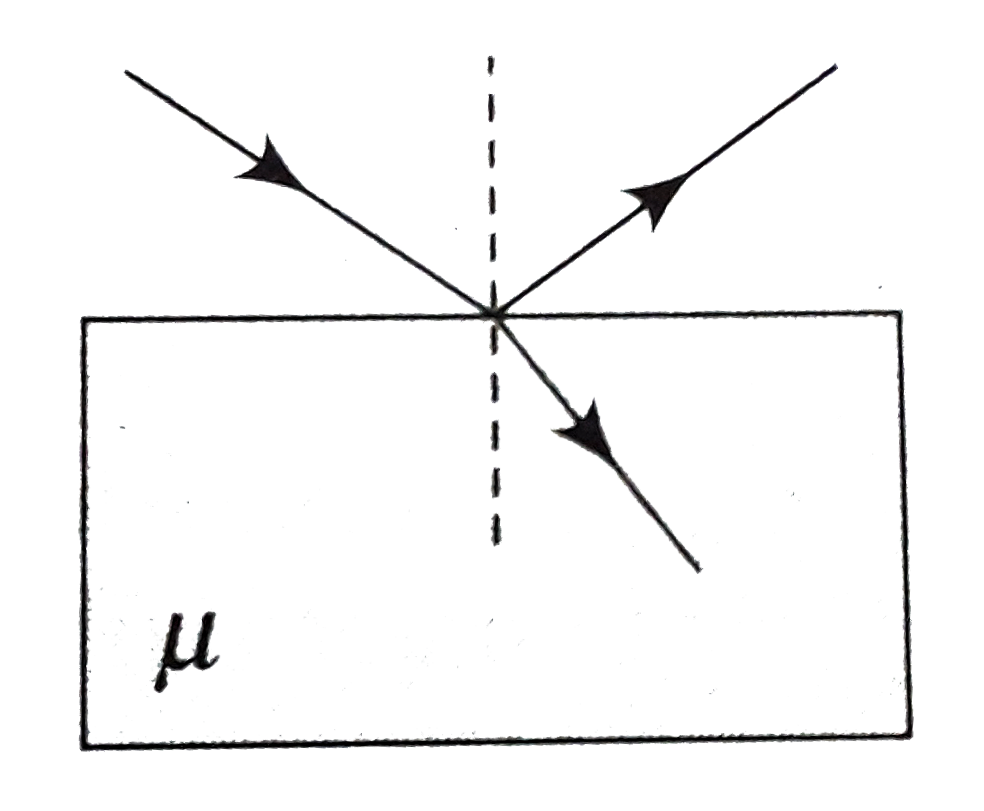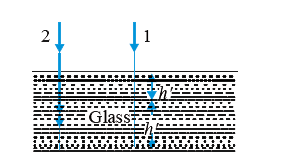A light ray is travelling from air to glass. True reflected and refracted rays are perpendicular to each other. If the angle of incidence in air is I the refractive index of glass is
sin i
cos i
tan i
cot i
The correct Answer is:C
To solve the problem, we will follow these steps:
Step 1: Understand the situation
We have a light ray traveling from air into glass. The angle of incidence in air is I, and we know that the reflected ray and the refracted ray are perpendicular to each other.
Step 2: Draw the diagram
Draw a diagram showing the incident ray, reflected ray, and refracted ray. Label the angle of incidence I and the angle of reflection (which will also be I due to the law of reflection).
Step 3: Determine the angles
Since the reflected and refracted rays are perpendicular, we can express this relationship mathematically. If we denote the angle of refraction as r, we have:
Angle between reflected and refracted rays=90∘
Thus, we can write:
r+90∘=90∘+I⟹r=90∘−I
Step 4: Apply Snell's Law
Using Snell's Law, which states:
μ1sinI=μ2sinr
where μ1 is the refractive index of air (approximately 1), and μ2 is the refractive index of glass. We can substitute the known values:
1⋅sinI=μ2⋅sin(90∘−I)
Step 5: Simplify using trigonometric identities
Using the identity sin(90∘−I)=cosI, we can rewrite the equation:
sinI=μ2⋅cosI
Step 6: Solve for the refractive index
Rearranging the equation gives:
μ2=sinIcosI
This can be simplified to:
μ2=tanI
Conclusion
Thus, the refractive index of glass is given by:
μ=tanI
Final Answer
The refractive index of glass is tanI.
---
We have a light ray traveling from air into glass. The angle of incidence in air is I, and we know that the reflected ray and the refracted ray are perpendicular to each other.
Draw a diagram showing the incident ray, reflected ray, and refracted ray. Label the angle of incidence I and the angle of reflection (which will also be I due to the law of reflection).
Since the reflected and refracted rays are perpendicular, we can express this relationship mathematically. If we denote the angle of refraction as r, we have:
Angle between reflected and refracted rays=90∘
Thus, we can write:
r+90∘=90∘+I⟹r=90∘−I
Using Snell's Law, which states:
μ1sinI=μ2sinr
where μ1 is the refractive index of air (approximately 1), and μ2 is the refractive index of glass. We can substitute the known values:
1⋅sinI=μ2⋅sin(90∘−I)
Using the identity sin(90∘−I)=cosI, we can rewrite the equation:
sinI=μ2⋅cosI
Rearranging the equation gives:
μ2=sinIcosI
This can be simplified to:
μ2=tanI
Thus, the refractive index of glass is given by:
μ=tanI
The refractive index of glass is tanI.
Topper's Solved these Questions
- RAY OPTICS AND OPTICAL INSTRUMENTSBook:AAKASH INSTITUTE ENGLISHChapter:RAY OPTICS AND OPTICAL INSTRUMENTSExercise:Assignment (Section - B) Objective Type Questions (One option is correct)
Explore 15 Videos
- RAY OPTICS AND OPTICAL INSTRUMENTSBook:AAKASH INSTITUTE ENGLISHChapter:RAY OPTICS AND OPTICAL INSTRUMENTSExercise:Assignment (Section - C) Objective Type Questions (More than one option are correct)
Explore 9 Videos
- RAY OPTICS AND OPTICAL INSTRUMENTSBook:AAKASH INSTITUTE ENGLISHChapter:RAY OPTICS AND OPTICAL INSTRUMENTSExercise:ASSIGNMENT (SECTION - D)
Explore 16 Videos
- PHYSICAL WORLDBook:AAKASH INSTITUTE ENGLISHChapter:PHYSICAL WORLDExercise:ASSIGNMENT (Section-B)
Explore 4 Videos
- SEMICONDUCTOR ELECTRONICS (MATERIAL, DEVICES AND SIMPLE CIRUITS )Book:AAKASH INSTITUTE ENGLISHChapter:SEMICONDUCTOR ELECTRONICS (MATERIAL, DEVICES AND SIMPLE CIRUITS )Exercise:Assignment SECTION - D (Assertion & reason type Question)
Explore 10 Videos
Similar Questions
Statement I: A light ray is incident on a glass slab. Some portion of it is reflected and some is refracted. Refracted and reflected rays are always perpendicular to each other.
Statement II: Angle of incidence is equal to angle of reflection.

View SolutionA ray of light is incident at an angle i from denser to rare medium. The reflected and the refracted rays are mutually perpendicular. The angle of reflection and the angle of refraction are respectively r and r'. Then the critical angle will be:

View Solution
Knowledge Check
Unpolarized light is incident on a plane glass surface. The angle of incidence so that reflected and refracted rays and perpendicular to each other, then
Ataniβ=μ2Btaniβ=μCsiniβ=μDcosiβ=μ
Unpolarised light is incident from air on a plane surface of a material of refractive index μ. At a particular angle of incidence i, it is found that the reflected and refracted rays are perpendicular to each other. Which of the following options is correct for this situation?
View SolutionUnpolarised light is incident from air on a plane surface of a material of refractive index .μ.. At a particular angle of incidence .I., it is found that the reflected and refracted rays are perpendicular to each other. Which of the following options is correct for this situation?
View SolutionA ray of light falls on a transparent glass slab of refractive index √2. If the reflected and refracted rays are mutually perpendicular, then the angle of incidence is
View SolutionA ray of light entering from air to glas (μ=1.5) is partly reflected and partly refracted. lf the reflected and refracted rays are at right angles to each other, the angle of refraction is
View SolutionA monochromatic ray of light passes from air to glass. The wavelength of light in air is λ, the speed of light in air is c and in glass is V. if the refractive index of glass is 1⋅5, write down (a) the relationship between c and V, (b) the wavelength of light in glass.
View SolutionA : When an unpolarised light is incident on a glass plate at Brewster angle, the reflected ray and refracted ray are matually perpendicular.
R : The refractive index of glass is equal to sine of the angle of polarisation.
View SolutionThe refracting angle of a glass prism is 30∘. A ray is incident onto one of the faces perpendicular to it. Find the angle δ between the incident ray and the ray that leaves the prism. The refractive index of glass is μ=1.5.
View Solution